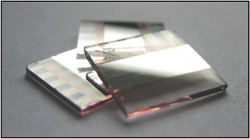Small-molecule solar cell boosts power efficiency
Scientists have made the first steps towards improving the efficiency of organic microelectronic devices by gaining a better understanding of the role of structure in solar cell efficiency, and of how to control that structure to produce a device with improved efficiency. Under the aegis of the LIFORGANICPV project, the researchers set out to produce a solar cell device based on small molecules for which the impact of the interfacial ordering can be understood and the efficiency modified by changes to that ordering. They wanted to achieve this by establishing the structure of lithium fluoride (LiF) on the surface of an ordered organic thin film and exploring the impact LiF deposition on the order of the underlying organic molecule, before relating any changes in structure near the interface to the performance of the device. The scientists said that over the course of the project, they managed to 'produce a workhorse device structure, modify the interfacial structure and control the device performance', gaining 'insights into how engineering of those interfaces can be used in the next generation photovoltaic devices'. Ref: Turak et al. Nanoscale Engineering of Exciton Dissociating Interfaces in Organic Photovoltaics Journal of Nano Research v14 p125 (2011)







